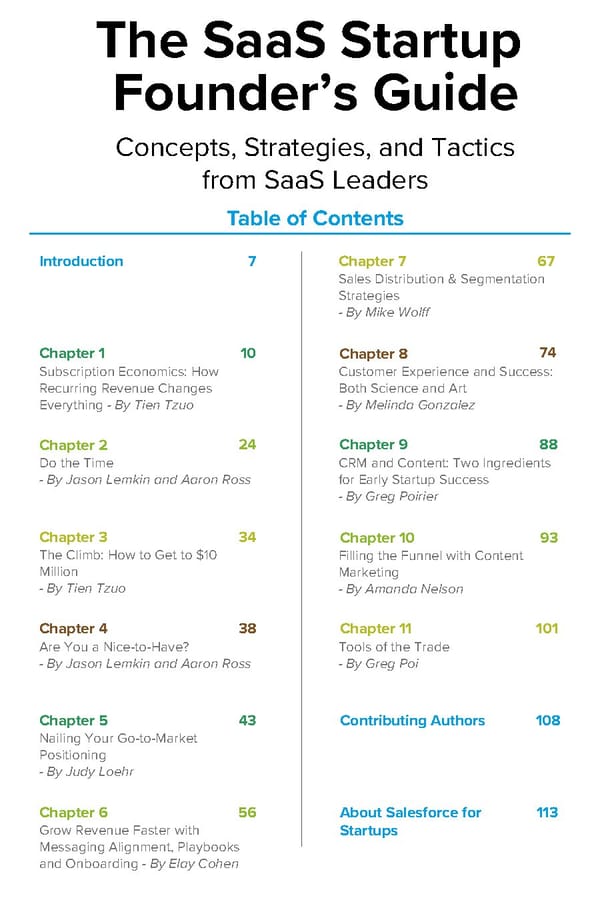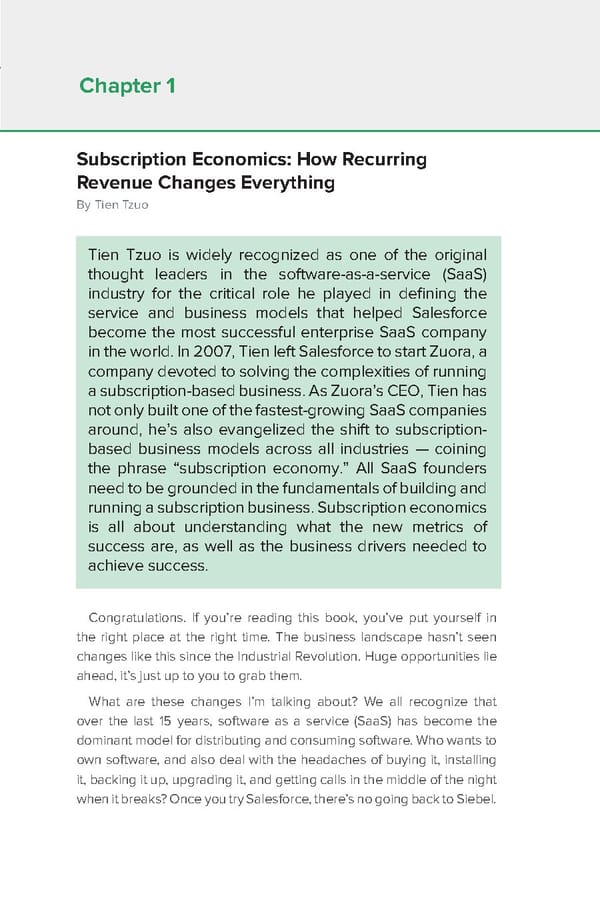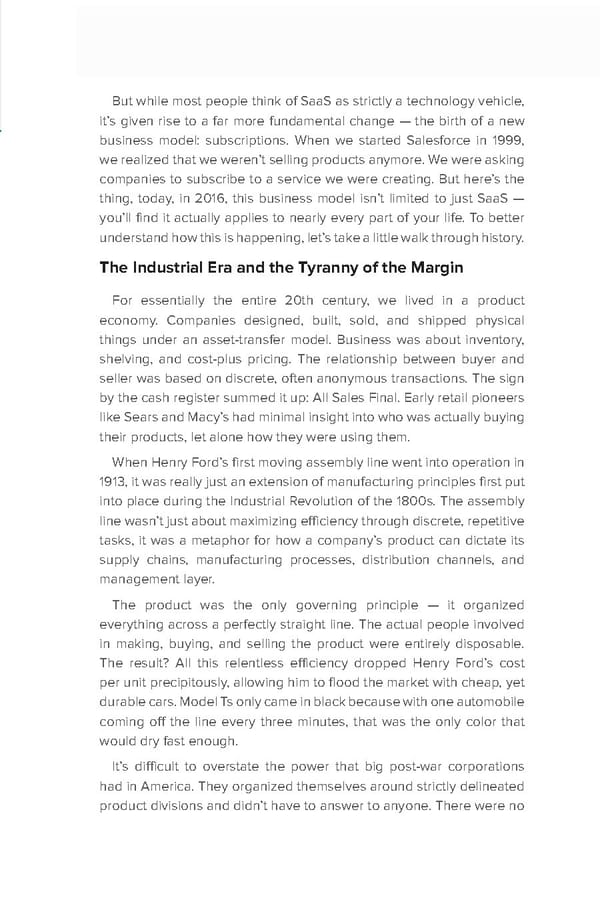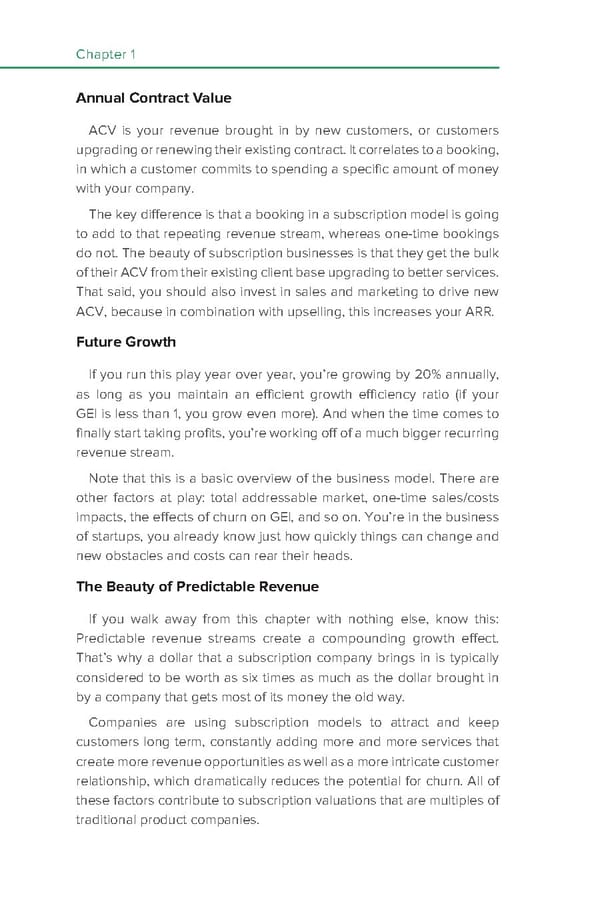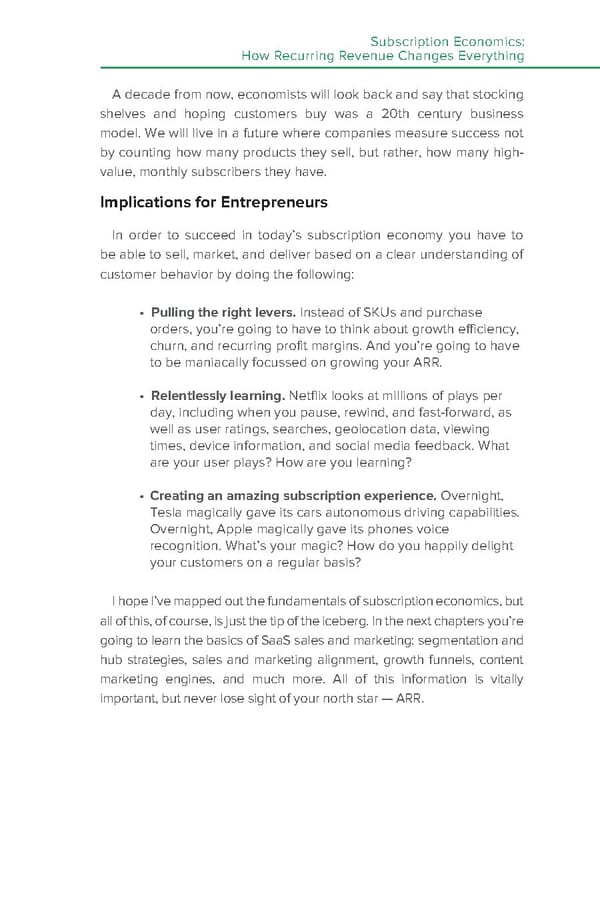Subscription Economics
By Tien Tzuo, Founder and CEO, @Zuora. Best Selling Author of "Subscribed"
The SaaS Startup Founder’s Guide Concepts, Strategies, and Tactics from SaaS Leaders Table of Contents Introduction 7 Chapter 7 67 Sales Distribution & Segmentation Strategies - By Mike Wolff Chapter 1 10 Chapter 8 74 Subscription Economics: How Customer Experience and Success: Recurring Revenue Changes Both Science and Art Everything - By Tien Tzuo - By Melinda Gonzalez Chapter 2 24 Chapter 9 88 Do the Time CRM and Content: Two Ingredients - By Jason Lemkin and Aaron Ross for Early Startup Success - By Greg Poirier Chapter 3 34 Chapter 10 93 The Climb: How to Get to $10 Filling the Funnel with Content Million Marketing - By Tien Tzuo - By Amanda Nelson Chapter 4 38 Chapter 11 101 Are You a Nice-to-Have? Tools of the Trade - By Jason Lemkin and Aaron Ross - By Greg Poi Chapter 5 43 Contributing Authors 108 Nailing Your Go-to-Market Positioning - By Judy Loehr Chapter 6 56 About Salesforce for 113 Grow Revenue Faster with Startups Messaging Alignment, Playbooks and Onboarding - By Elay Cohen
Chapter 1 Chapter 1 Subscription Economics: How Recurring Revenue Changes Everything By Tien Tzuo Tien Tzuo is widely recognized as one of the original thought leaders in the software-as-a-service (SaaS) industry for the critical role he played in defining the service and business models that helped Salesforce become the most successful enterprise SaaS company in the world. In 2007, Tien left Salesforce to start Zuora, a company devoted to solving the complexities of running a subscription-based business. As Zuora’s CEO, Tien has not only built one of the fastest-growing SaaS companies around, he’s also evangelized the shift to subscription- based business models across all industries — coining the phrase “subscription economy.” All SaaS founders need to be grounded in the fundamentals of building and running a subscription business. Subscription economics is all about understanding what the new metrics of success are, as well as the business drivers needed to achieve success. Congratulations. If you’re reading this book, you’ve put yourself in the right place at the right time. The business landscape hasn’t seen changes like this since the Industrial Revolution. Huge opportunities lie ahead, it’s just up to you to grab them. What are these changes I’m talking about? We all recognize that over the last 15 years, software as a service (SaaS) has become the dominant model for distributing and consuming software. Who wants to own software, and also deal with the headaches of buying it, installing it, backing it up, upgrading it, and getting calls in the middle of the night when it breaks? Once you try Salesforce, there’s no going back to Siebel.
Chapter 1 Subscription Economics: How Recurring Revenue Changes Everything But while most people think of SaaS as strictly a technology vehicle, it’s given rise to a far more fundamental change — the birth of a new business model: subscriptions. When we started Salesforce in 1999, we realized that we weren’t selling products anymore. We were asking companies to subscribe to a service we were creating. But here’s the thing, today, in 2016, this business model isn’t limited to just SaaS — you’ll find it actually applies to nearly every part of your life. To better understand how this is happening, let’s take a little walk through history. The Industrial Era and the Tyranny of the Margin For essentially the entire 20th century, we lived in a product economy. Companies designed, built, sold, and shipped physical things under an asset-transfer model. Business was about inventory, shelving, and cost-plus pricing. The relationship between buyer and seller was based on discrete, often anonymous transactions. The sign by the cash register summed it up: All Sales Final. Early retail pioneers like Sears and Macy’s had minimal insight into who was actually buying their products, let alone how they were using them. When Henry Ford’s first moving assembly line went into operation in 1913, it was really just an extension of manufacturing principles first put into place during the Industrial Revolution of the 1800s. The assembly line wasn’t just about maximizing efficiency through discrete, repetitive tasks, it was a metaphor for how a company’s product can dictate its supply chains, manufacturing processes, distribution channels, and management layer. The product was the only governing principle — it organized everything across a perfectly straight line. The actual people involved in making, buying, and selling the product were entirely disposable. The result? All this relentless efficiency dropped Henry Ford’s cost per unit precipitously, allowing him to flood the market with cheap, yet durable cars. Model Ts only came in black because with one automobile coming off the line every three minutes, that was the only color that would dry fast enough. It’s difficult to overstate the power that big post-war corporations had in America. They organized themselves around strictly delineated product divisions and didn’t have to answer to anyone. There were no
Chapter 1 call centers, no customer service reps, and in many cases, no returns. This model didn’t work particularly well when it came to customers like you and me, but it shipped units and kept boardrooms happy. Fast-forward a few decades, and the emergence of Oracle enterprise resource planning (ERP) systems in the 1980s only exacerbated this problem. Their systems did a good job of measuring operational efficiency — raw materials, inventory, purchase orders, shipping, and payroll — but did a lousy job of measuring actual customer experience. To a fault, companies tend to manage what they can measure, so executive teams became hopelessly product-focused, both organizationally and strategically. This decade also saw the ascendance of supply chain economics. The goal was to match supply and demand with the least inventory possible. It was nirvana for engineers and management consultants, who were threatened by the new electronic products and efficiencies coming out of Japan. “Just in Time” inventory meant that warehouses full of stuff just sitting around were the ultimate enemy. “Total Quality Management” meant that the work of improving processes was never over. Michael Dell built an empire based around these disciplines, as did many other eager entrepreneurs during the era. Then, in the mid-90s, corporate America woke up to the realization that all this relentless focus on productivity was coming at a cost, namely, the relationship between vendor and customer. The customer was a complete unknown, a receptacle at the end of a distribution chain whose sole purpose was to consume the products companies made. But as it turned out, many of these new consumers were having difficulty getting their new products to work. And how did corporate America discover this? Their receptionists were getting angry phone calls. So what did the big companies do to address this problem? They set up customer service departments. In a knee-jerk attempt to solve the problem, companies built yet another vertical silo. They launched market services, technical support lines, warranty contracts, and maintenance groups. The customer had truly arrived and now she had her own department. And that department was located way down at the far end of the supply chain, just past the loading dock.
Chapter 1 Subscription Economics: How Recurring Revenue Changes Everything For what it’s worth, all the major MBA programs were just as widget- obsessed (at least mine was). I was taught that the fundamental goal of business is to create a hit product. Then, I had to sell as many units of that product as possible, thereby spreading my fixed costs over as many units as I could, so I could compete on the all-powerful margin. All I had to do was deploy SAP better than everyone else. It was all completely worthless advice. The Shift to Monetizing Relationships As the eleventh hire at Salesforce, I was privileged to be able to help build not just a new kind of customer relationship management (CRM) system, but a whole new approach to enterprise applications. Many of us early employees had become disillusioned over the state of the enterprise software industry. As we approached the turn of the century, companies like Oracle, Siebel, and others were creating a needlessly complicated product that was sold by a mercenary sales force and promoted by a parasitic systems integration industry. Everyone made money. Everyone, that is, except the customer. At the same time, we looked on in wonder at this new experience being introduced by the Internet. This is what we wanted, to build a new kind of user experience, where using software would be as easy as buying a book on Amazon. But as we got into it, we realized this required us to change our whole way of thinking. We had to reevaluate the whole purpose of a software company, changing the fundamental question from, “How many products can I sell?” to, “What does my customer want, and how can I deliver that as an intuitive service?” It wasn’t just about shifting units anymore. It was about growing and monetizing a dedicated customer base. What about the SaaS model forced us to think of customers? Sure, technology drove us to offer our product over the Internet. After all, the vision was as easy as buying a book on Amazon. But that required us to think of what we did as a service, something that people subscribed to, and that forced us to put ourselves in a position in which we were always working to please the customer. All of a sudden, we cared less about what product features sounded cool, and focused instead on what customers were using and what they actually needed.
Chapter 1 As a result, we didn’t start with a list of impressive-sounding product features. We started with lots of questions. Marc Benioff was like a one-man consumer survey operation. His pitch meetings were more like focus groups. He was constantly peppering his prospects with questions so he could engineer a killer product. The Subscription Economy Over the past decade, the Internet, spread by mobile technologies, has forced more and more businesses to start thinking the same way — to take a customer-first mindset. Amazon, Netflix, and Zipcar all reinvented what they did as a service. They tracked customer preferences, tailored their offering to individual needs, and always favored the long-term view of creating lifetime customer value. The focus shifted from the transaction, to the customer. So instead of selling static products that evaporated after checkout, along with their customers, they could offer ongoing services that resulted in smart, responsive relationships. Running on a subscription model, they could offer lower upfront costs, continuously improve their offering, and learn way more about their customers through usage and behavior analytics. The customer was no longer the ghost in the ERP. Today, everything is moving to a subscription economy. Media, transportation, agriculture, health care, consumer goods, education — companies have woken up to the fact that people want outcomes, not ownership. They want customized experiences. And they want continuous improvement, not planned obsolescence. CHANNELS CHANNELS
Chapter 1 Subscription Economics: How Recurring Revenue Changes Everything One simple but effective way of looking at this is that companies have started to sell outcomes, using their product as a means to an end. Uber and Lyft sell you the ride, not the car. Caterpillar used to sell movers to construction companies. Now it asks them how much dirt they need moved. Health trackers are throwing in their actual product for free, in exchange for a 12-month subscription to their analytics platform. Teslas update themselves with the latest technologies and become smarter over time, so you don’t need to buy another car. In short — this isn’t a software story anymore. The New Priorities We use this diagram a lot at Zuora (see p. 14). It summarizes the shift. On the left side, companies used to focus on getting a product to market, aligning their sales and distributi on channels around specific product lines. Today, they recognize that customers spend their time across many channels, and wherever those customers are, that’s where they should be meeting their customers’ needs. The glory days of the soulless, all-powerful corporation are long gone. Companies had to change, because society did. Today’s customers are more informed. Most of them have researched, assessed, and categorized you before you can even say hello. And to most of them, especially younger ones, ownership just isn’t that important anymore. People increasingly view the prospect of buying something as unnecessary baggage. They want media at their fingertips, not physical products to manage. That’s why most of the big dinosaur retailers I grew up with are extinct now: Circuit City, Tower Records, Blockbuster, Borders, Virgin Megastore, and so on. Today, people expect services to provide immediate, ongoing fulfillment, from rideshares to streaming services to subscription boxes. They want to be happily surprised on a regular basis. And if you don’t meet those expectations, you get dropped, not to mention trashed on social media. It’s that simple. This means that everything has changed: how you design your service, how you engage with your customers, how you manage your company, heck, even how you define what really constitutes a company anymore. But as a first step, let’s start something more fundamental. Let’s explore the basic economics and components behind this unique new business model.
Chapter 1 The New Income Statement There’s a lot of great material out there on subscription economics. I’m going to try to start this discussion by boiling everything down to a simple framework. Let’s start with two income statements — the old versus the new. Here’s a traditional product income statement that they teach in any Business 101 class (numbers delineated in millions). Traditional Product Income Statement: Net Sales $ 100 Cost of Goods Sold (COGS) (40) Gross Income 60 Sales & Marketing (20) General & Administrative (10) Research & Development (20) Net Income $ 10 Pretty straightforward, right? According to this basic calculation, you sold one or more units of a product at a total sale of $100 million. The income statement brings out the costs that went into that unit. There are four fundamental costs: 1. How much it took to make that unit (COGS), including the raw materials, production costs, and so on. 2. How much it took to sell that unit. For example, commissions to salespeople, money for the channel, and so on. 3. How much overhead management needed to run the company. The more units you sell, the lower your overhead cost per unit. 4. How much the company is spending in R&D to create the next hit product. The money you received for the product, minus the cost of the product, is the gross income, otherwise known as the gross margin when expressed as a percentage, and is one of the most important margins in the old economy. Unfortunately, this picture is entirely wrong for a subscription business, for three main reasons:
Chapter 1 Subscription Economics: How Recurring Revenue Changes Everything 1. It’s a backward-looking picture. This is a preterite framework — it’s all about money already earned, expenses already paid, actions already taken. Subscription businesses are all about forward visibility — how much money I know I can count on over the next 12 months, so I can account, plan, and spend accordingly. 2. Sales and marketing are matched to past goods sold. It’s essentially a sunk cost. Subscription businesses need to think strategically about sales and marketing spend going toward driving future business. 3. This statement does not differentiate between recurring and nonrecurring dollars. That’s a fundamental oversight. That’s like saying there’s no difference between a dollar and a dollar that keeps buying every year for the next 10 years. Smart subscription businesses don’t think like this. Instead of revenue, they focus more on annual recurring revenue (ARR). Here’s a new income statement that illustrates this thinking. Subscription Economy Income Statement Annual Recurring Revenue $ 100 Churn (10) Net ARR 90 Cost of Goods Sold (20) General & Administrative (10) Research & Development (20) 40 Sales & Marketing (30) Net Income 10 New ACV 30 Ending ARR $ 120
Chapter 1 ARR The first thing to notice here is that instead of starting and ending with net income, now we’re starting and ending with ARR. That’s because smart subscription businesses know that not all revenue is revenue, just like you and I know that there is a difference between a one-time payment and a recurring payment. Smart subscription businesses are obsessed with ARR, which is the amount of revenue that they expect their install base to repeat every year. While in a traditional financial statement, revenue indicates how much revenue you made, in a subscription economy income statement, ARR is a forward-looking number. Subscription economy companies actually start the year knowing what their revenues are going to be. In the example above, the company with $100 million of ARR can count on that money at the beginning of every year. That figure is stable and predictable, meaning they can plan better, forecast more accurately, and focus on achieving their monthly numbers. The same cannot be said of a $100 million business with no ARR. That company has to start the year at zero, and slowly scratch its way back to $100 million. Of course, it can make some predictions based on past performance, but it doesn’t have a contractually obligated revenue stream to base ambitious expansion plans around. For a subscription business, more so than cash or revenue, ARR is the true indicator of your company’s health. Churn In its simplest sense, churn is the number (often noted in revenue) of subscribers who will not renew. Typically, downsells are also factored into your churn number. If a customer churns at the end of the year, there will be no impact on that year’s revenue, but it will impact your ARR. Churn sucks, but even if you’ve got the best offering in the market, you’ll still have customers that leave you — they switch business models, or your competitor poaches them with a shameless discount. Taking this into account, you’ll need to subtract your expected churn in the top-line from your ARR for the year to get a net ARR.
Chapter 1 Subscription Economics: How Recurring Revenue Changes Everything Recurring Costs In a SaaS company, there are really just three sources of costs: people, data center, and sales and marketing. In the subscription income statement these costs are allocated into four key buckets: 1. Costs of Revenue: Otherwise known as COGS (costs of goods sold), which is how much you need to spend to actually provide the service. In a SaaS company, this typically includes the data center, the hardware, the data center folks, technical support folks, and so on. In an IoT company, these expenses include the costs of your hardware and connectivity. In a subscription box company, they include the costs of the products you ship. 2. Research and Development: This includes all the developers and product managers. 3. General and Administrative: This includes primarily the finance and HR folks. 4. Sales and Marketing: This includes the sales (including customer success) and marketing departments and supporting personnel, and any money spent on marketing programs. Now, most traditional income statements take these cost buckets and map that to revenue to get a margin. Revenue minus costs of revenue, for example, is your gross margin. And at the heart of traditional financial accounting is the concept of matching. When $1 is shown as revenue on the income statement, it shows all of these fixed costs that went into making that one dollar. Unfortunately, the whole concept of matching starts to break down for subscription business models. We’re going to do something different and compare these costs to ARR. Why ARR? Because ARR represents revenue acquired in previous periods, which is now recurring. Sure, you need to keep servicing your customers, so COGS and G&A should match to ARR. How about R&D? Well, the traditional view says the products you’re selling today are already done, and you’re investing in research to create innovations that drive future sales. But here’s the thing: The customers of SaaS companies did not sign up for a static service that never gets better.
Chapter 1 If you know anything about SaaS companies, you know they’re obsessed with keeping their customers happy, and to keep them buying the service, they invest in R&D against that goal. At Salesforce, we started naming releases with the seasons, for example, the Winter 2013 Release, to convey the constant rate we expected to add enhancements to the products. That’s why I like to think of R&D as being matched to ARR. Sales and marketing are where it gets interesting. If your ARR represents today’s revenue that you expect to recur, then your spend on sales and marketing is going toward growing ARR, to acquiring future revenue that is not yet in ARR. In other words, today’s sales and marketing expenses are matched to future revenue. In traditional accounting lingo, your sales and marketing now act more like a capital expenditure, or capex, for short. In the old manufacturing world, you invested in a big factory to build a bunch of widgets, and you spread the cost of that factory out over time as you made and sold those widgets over time. That’s called depreciation. Similarly in the subscription economy, you invest in sales and marketing to acquire customers, and you recognize revenue from those customers over their lifetime, which often can be three, five, 10 years, or more. However, accounting rules today do not let you spread (or depreciate) sales and marketing costs over time (though some companies amortize commission costs over the contracted term). The big difference is that you generally expect ARR to continue beyond the initial contract term. That’s why we don’t match sales and marketing to current ARR. We tie it to a very important metric, your recurring profit margin. Recurring Profit Margin Your recurring profit margin (RPM) is simply the difference between your recurring revenues and your recurring costs. It’s your ARR minus your COGS, R&D, and G&A, but before the spend on sales and marketing. In the income statement couple pages earlier, it’s $40 million, which represents a very healthy margin. This is the number that funds growth. As long as your subscription company has a positive RPM, it can choose between growth and profitability. If you spend less than the RPM, you’ll grow less, but be profitable. If you spend more than the RPM, you’ll grow more, but lose money.
Chapter 1 Subscription Economics: How Recurring Revenue Changes Everything RPM is also hugely important when it comes to future budget allocation. If you start the year with a fixed amount of ARR, then you’ll know what you can spend on COGS, R&D, and G&A in order to arrive at a specifically desired RPM. Remember, this is a forward-looking statement. Now, what’s the number that dictates how much you can spend on sales and marketing? This is another number that you won’t find on the income statement, but it’s hugely important. It’s your growth efficiency index (GEI). Growth Efficiency Index Let’s say you spend $1 million on sales, marketing, and customer success, in other words, efforts intended to grow new business, from new customers or old. How many new recurring revenue dollars does that buy you? This is your GEI, which tells you how much you will grow. GEI is calculated as growth expense/new ACV. If your GEI is greater than 1, you’re currently spending more money on new business than you’re taking in. If your GEI is less than 1, you’re spending less than you’re taking in. Efficient subscription companies naturally target a GEI of 1 or less, though initially the cost of new sales may be higher, as the company invests in acquiring strategic customers whose revenue (and profits) won’t build until later years. Note that the greater the GEI, the less efficient the company is at actually growing their sales — just the opposite of what you’d expect. A low GEI means that for the same number of dollars you’ll generate more sales, and that’s a good thing. In the subscription income statement a few pages earlier, you have a recurring profit of $40 million on a beginning ARR of $100 million. Do you take the $40 million off the table and book it as profits? A 40% annual profit margin isn’t bad. Then again, you won’t see as much growth as you would if you reinvested in your new revenue growth levers. Instead, let’s be bullish and invest $30 million back in sales, marketing, and customer success — growth. With a GEI of 1, you’ll book $30 million in net new annual contract value (ACV) over the course of the next year, leaving you with $120 million in ARR.
Chapter 1 Annual Contract Value ACV is your revenue brought in by new customers, or customers upgrading or renewing their existing contract. It correlates to a booking, in which a customer commits to spending a specific amount of money with your company. The key difference is that a booking in a subscription model is going to add to that repeating revenue stream, whereas one-time bookings do not. The beauty of subscription businesses is that they get the bulk of their ACV from their existing client base upgrading to better services. That said, you should also invest in sales and marketing to drive new ACV, because in combination with upselling, this increases your ARR. Future Growth If you run this play year over year, you’re growing by 20% annually, as long as you maintain an efficient growth efficiency ratio (if your GEI is less than 1, you grow even more). And when the time comes to finally start taking profits, you’re working off of a much bigger recurring revenue stream. Note that this is a basic overview of the business model. There are other factors at play: total addressable market, one-time sales/costs impacts, the effects of churn on GEI, and so on. You’re in the business of startups, you already know just how quickly things can change and new obstacles and costs can rear their heads. The Beauty of Predictable Revenue If you walk away from this chapter with nothing else, know this: Predictable revenue streams create a compounding growth effect. That’s why a dollar that a subscription company brings in is typically considered to be worth as six times as much as the dollar brought in by a company that gets most of its money the old way. Companies are using subscription models to attract and keep customers long term, constantly adding more and more services that create more revenue opportunities as well as a more intricate customer relationship, which dramatically reduces the potential for churn. All of these factors contribute to subscription valuations that are multiples of traditional product companies.
Chapter 1 Subscription Economics: How Recurring Revenue Changes Everything A decade from now, economists will look back and say that stocking shelves and hoping customers buy was a 20th century business model. We will live in a future where companies measure success not by counting how many products they sell, but rather, how many high- value, monthly subscribers they have. Implications for Entrepreneurs In order to succeed in today’s subscription economy you have to be able to sell, market, and deliver based on a clear understanding of customer behavior by doing the following: • Pulling the right levers. Instead of SKUs and purchase orders, you’re going to have to think about growth efficiency, churn, and recurring profit margins. And you’re going to have to be maniacally focussed on growing your ARR. • Relentlessly learning. Netflix looks at millions of plays per day, including when you pause, rewind, and fast-forward, as well as user ratings, searches, geolocation data, viewing times, device information, and social media feedback. What are your user plays? How are you learning? • Creating an amazing subscription experience. Overnight, Tesla magically gave its cars autonomous driving capabilities. Overnight, Apple magically gave its phones voice recognition. What’s your magic? How do you happily delight your customers on a regular basis? I hope I’ve mapped out the fundamentals of subscription economics, but all of this, of course, is just the tip of the iceberg. In the next chapters you’re going to learn the basics of SaaS sales and marketing: segmentation and hub strategies, sales and marketing alignment, growth funnels, content marketing engines, and much more. All of this information is vitally important, but never lose sight of your north star — ARR.

